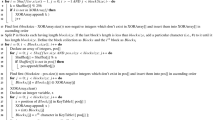Abstract
By researching into the attack to present block cipher, we find an essential reason leading to the assailable encryption strength, set up a new block cipher idea and put forward a block cipher encryption concept path encryption. We present permutation code encryption which is based on path encryption. Now permutation code encryption is a patent of Chinese invention. In Permutation Code Encryption, we use a pseudo-random sequence of the keys to control the paths. The simulation result shows that forn-bit block the encryption strength is novel higher than 2″ and the algorithm can finish the encryption of one block in 7.5 ns, which is unrelated with the block length.
Similar content being viewed by others
References
Jakimoski G, Desmedt Y. Related-Key Differential Cryptanalysis of 192-Bit Key AES Variants[C]//10th Annual International Workshop SAC 2003. Berlin: Springer, 2004: 208–221.
Kajiwara H, Takahira K, Katayama T. Development of DES Analysis and Synthesis Toolbox[C]//SICE 2003Annual Conference. Fukui: IEEE Press, 2003: 234–238.
Matsui M. Linear Cryptanalysis Method for DES Cipher [C]//Workshop on the Theory and Application of Cryptographic Techniques on Advances in Cryptology. New York: Springer-Verlag, 1994: 386–397.
Wang Lin. Crypto-Analysis of the Encryption Algorithm Rijndael[J].The Journal of China University of Posts and Telecommunications, 2001,8(2):32–34(Ch).
Biham E, Shamir A. Differential Cryptanalysis of DES-Like Cryptosystems[J].Journal of Cryptology, 1991,4(1):72.
Feng Dengguo.Cryptanalysis[M]. Beijing: Tsinghua University Press, 2000(Ch).
Feng Dengguo, Pei Dingyi.the Introduction of Cryptology [M]. Beijing: Science Press, 1999(Ch).
Lin Zi, Xu Yong, Li Kuijun. CRH Public Encryption—The Study on High Intensity Data Encryption Algorithm[J].Journal of China University of Posts and Telecommunications, 2000,7(1):51–55(Ch).
Gurkaynak F K, Burq A. A 2 Gb/s Balanced AES Crypto-Chip Implementation[C]//Proceedings of the 2004ACM Greatlakes Symposium on VLSI, New York: ACM Press, 2004:39–44.
Paris K, Nicolas S. An FPGA-Based Performance Comparison of the 64-Bit Block Ciphers[C]//5th International Symposium on Intelligent Automation and Control. New York: IEEE Press, 2004:427–432.
Author information
Authors and Affiliations
Corresponding author
Additional information
Biography: WU Jinmu (1946-), male, Professor, research direction: cryptography, information security.
Rights and permissions
About this article
Cite this article
Jinmu, W., Maohua, L., Guiqin, F. et al. Permutation code encryption—New achievement based on path encryption. Wuhan Univ. J. Nat. Sci. 11, 1581–1584 (2006). https://doi.org/10.1007/BF02831825
Received:
Issue Date:
DOI: https://doi.org/10.1007/BF02831825




